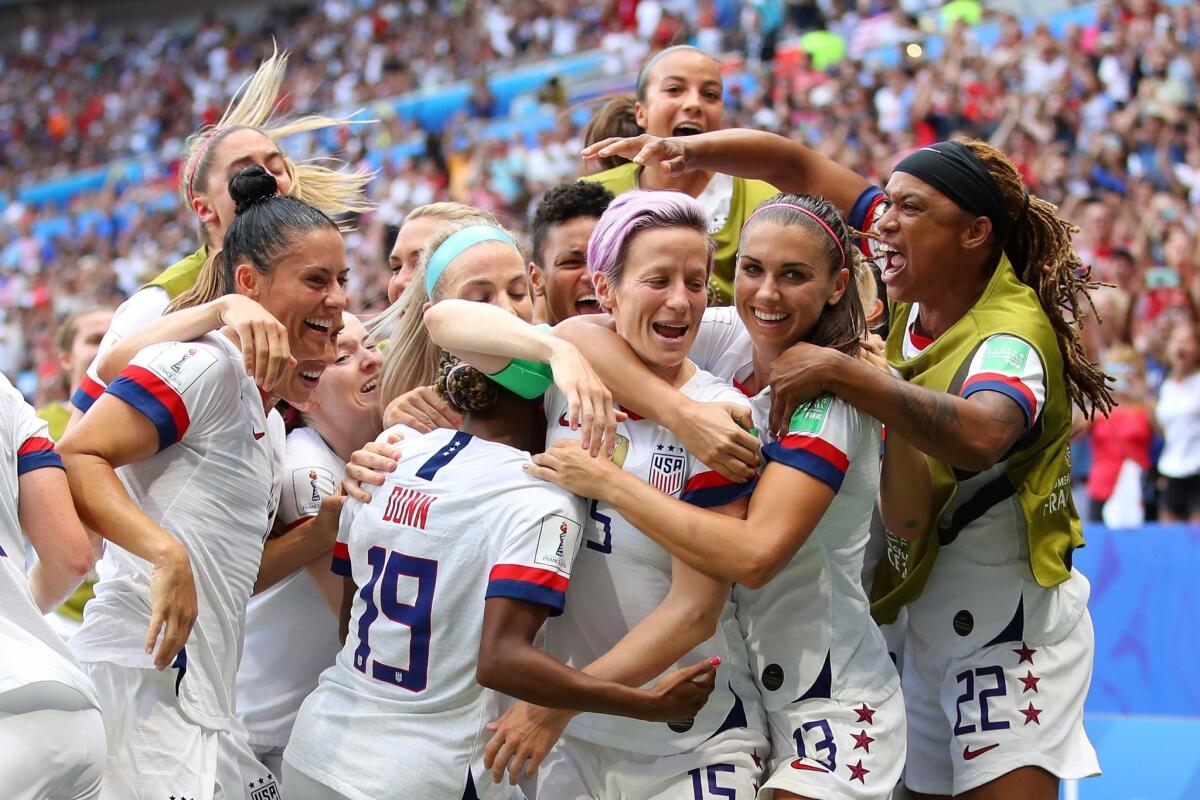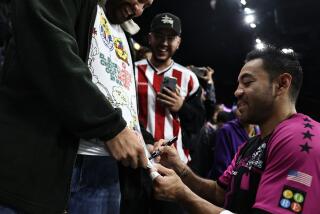Op-Ed: If the goal is equity, the U.S. women and men should team up to bargain with U.S. Soccer

- Share via
The two-time defending World Cup champion U.S. women’s soccer team has gone 31 games without a loss, but it suffered a stunning defeat in May when a federal judge dismissed the equal-pay claims in its gender-discrimination lawsuit against the U.S. Soccer Federation. The players this month hired lawyers with extensive Supreme Court experience in advance of an appeal, and what remains of the case could continue in the court system for years if the two sides can’t reach a settlement.
Large swaths of public opinion support the players and equal pay, and even the U.S. men’s team — which has sometimes had chilly relations with the women — responded to the ruling with this statement: “The USMNT players continue to stand with the WNT players in their efforts to secure equal pay.”
Achieving that goal isn’t simple. The women’s team has signed a collective bargaining agreement with U.S. Soccer that enshrines a different pay structure (providing more security by guaranteeing base salaries, including for day-to-day club play) than that of the men’s team (based entirely on bonuses for international play). There is far more money in men’s club play than in women’s, which explains each group’s desire for different levels of security in its national-team pay.
Soccer is the world’s most democratic sport — played everywhere a goal can be marked out and something kickable is available — but not when it comes to gender equity. Finding a solution for equal pay in American soccer would be a victory for the reach and spirit of the sport here and an inspiration in many other countries, whose women’s teams have historically lagged behind the men’s in support.
U.S. Soccer says it seeks “a path forward” with the women’s team, including a settlement of the court case. I would propose that there is only one way to proceed after that: The U.S. women’s and men’s teams should negotiate their next collective bargaining agreements jointly with U.S. Soccer.
The men are still playing under an agreement that expired at the end of 2018; the women’s CBA extends only through 2021. In a few other countries, including Australia, New Zealand and Norway, the national teams together have negotiated with their federations and the men and women have both been satisfied in the end. The two U.S. teams would have more leverage together, especially with the threat of a double-barreled work stoppage heading into 2022, when the men’s World Cup is scheduled.
Joint negotiations wouldn’t mean the U.S. women and men would have to agree to the exact same terms with U.S. Soccer. The women may still want more security, and the men may still want less money guaranteed and more bonus income. Operating as one unit wouldn’t prevent the teams from creatively determining what they view as “equal” pay, while maintaining strict equity on apples-to-apples comparisons, such as travel support.
Former national team player Julie Foudy has proposed one way to add balance to pay: Combine a portion of all revenues brought in by the men’s and women’s teams — including sponsorships (where the women currently take precedence), FIFA tournament prize money (where the men earn more) and television rights income (which fluctuates) and divide the pot 50-50.
U.S. Soccer’s motto is “One Nation, One Team,” and seeing the women and men band together on the issue of pay would be one of its best possible manifestations. Carli Lloyd, the two-time world player of the year, recently told me she would like to see occasional joint training camps and practices to help build camaraderie and mutual support. (Why not have those camps in Southern California and conclude with a doubleheader against archrival Mexico at the Rose Bowl?) When Alex Morgan and Allie Long met up with U.S. men’s star Christian Pulisic after a UEFA Champions League game a few years ago, it was unusual enough to merit a mention in my reporting in Sports Illustrated.
So far, the public support from the men’s team for the women and equal pay has come from official statements. It’s time for the players to speak up forcefully, especially Pulisic (who plays for England’s Chelsea) and emerging star Tyler Adams (a midfielder for Germany’s RB Leipzig), who will probably captain the U.S. men for the next decade or more.
Another emerging star for the U.S. men is Giovanni Reyna, a 17-year-old winger playing for Germany’s Borussia Dortmund. He’s the son of Danielle and Claudio Reyna, former U.S. national team players who first met when the two teams shared the same hotel during training camps in 1994. Nobody is saying today’s U.S. men’s and women’s teams need to get that close. But a new era of solidarity could advance the sport in the U.S. and become a symbol for men’s and women’s soccer teams in other countries, to say nothing of any workplace in the United States. One Nation, One Team.
Grant Wahl covered soccer for Sports Illustrated for 23 years. He is the author of “The Beckham Experiment” and “Masters of Modern Soccer.” His podcast is “Fútbol with Grant Wahl.”
More to Read
A cure for the common opinion
Get thought-provoking perspectives with our weekly newsletter.
You may occasionally receive promotional content from the Los Angeles Times.










